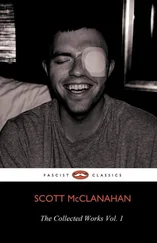The bulk of the internal wiring was left undone, as they couldn’t use most of the electrical equipment anyway. Larry said it was just as well, as he had expected to take at least a week to do a proper job of the wiring. Like most sailors, he had amassed quite a collection of flashlights, LED lanterns, and other gear such as portable navigation lights that could run off of disposable batteries. He made it a point to always keep a fairly large stock of these batteries stored for his voyages. This way, he said, at least they would have lights when they really needed them.
The main propulsion system for the Tiki 36 was an aerodynamic mainsail that fit over the round aluminum mast by means of a sewn-in sleeve. Larry said the sleeve was like that of a windsurfer sail, providing a clean air flow and functioning like the much more expensive rotating wingmasts found on million-dollar racing catamarans. Headsails of various sizes could be fitted on the forestay, which, like all the standing rigging, was made of a high-tech synthetic rope, rather than heavier stainless-steel wire, which Larry said was now passé in the performance sailing world. Auxiliary propulsion for maneuvering in harbors and through calms was supposed to be provided by two Yamaha 20-horsepower four-stroke outboards, fitted in motor wells under the cockpit decks port and starboard. Larry said that since theYamahas were brand new and over-reliant on technology, with electric starters and alternators, and electronic fuel injection, they would be leaving them behind. In their place, he mounted in the starboard motor well a single Evinrude 25-horsepower two-stroke that dated back to the late 1970s. “It’ll be enough to get us out of a tight spot if we need it,” he said, “and it’ll usually crank after a few pulls. But you’ll see, this boat will sail so well I doubt we’ll ever bother. Losing the weight of those two Yamahas will help too.”
When the time came to launch, on the third day after they’d arrived in Culebra’s harbor aboard Celebration , they dismantled the temporary tarp shed on the beach and cleared away the workbenches and ladders from the hulls. They stepped the mast by hoisting it up with a temporary gin pole lashed to its base and hooked to a block and tackle system. Then Larry rowed out into the harbor with the main anchor and set it at the limit of his longest rode, which was three hundred feet. It was Artie’s job to climb up into the cockpit and man the big manual winch that doubled as an anchor windlass “…since you did such a great job hoisting Celebration’ s anchor,” Larry said, while Larry and Scully worked at each keel, maneuvering the jacks and shifting skids from the sterns to the bows as the big cat slowly inched down the beach to the water. When they were within a foot of the wet sand above the tide line, Larry said they needed to stop to officially christen the boat before she went in. He disappeared into the starboard hull and came back down to the beach a minute later with a bottle of golden 10 Cane rum. “Trinidad’s best! I’ve been saving it for this moment. Here’s to the Casey Nicole ,” he said, as he splashed most of the bottle on the dull gray primer coating the twin bows and then offered the bottle to his brother. “Drink up, for a safe and successful voyage!”
Artie was surprised at what he heard. “I thought you were naming her Alegria .”
“That was then, this is now. My niece is the reason I’m launching today. Otherwise, I probably would have dragged on another year, piddling with this and that, trying to get everything perfect. Now I’m going to sail her today, and when we get Casey on board, everything will be perfect. Until then, I don’t think there’s going to be much alegria aboard anyway, especially not for you, Doc, and I totally understand.”
They took turns sipping from the bottle, Artie offering it to Scully only to learn that he wouldn’t touch alcohol. “A Rastaman don’t to drink, mon. Dat’s not I-tal. Only smoke de herb of wisdom. De rum is poison to de brain an’ not put on de Earth by Jah like he put de the ganja plant for a mon to use.”
“You’re full of shit, Scully, you know that?” Larry said as he took another pull from the bottle.
Once again, Artie was baffled by the strange ways of this character, Scully, and his confusing version of the English language. What kind of religion advocated smoking dope while prohibiting alcohol? He was learning something new about his brother’s friend every day. Despite that, he knew Casey would be thrilled to learn that her uncle had named his pride and joy after her. He couldn’t wait to see her face when she found out, and he asked Larry if they were going to paint the name on the sides.
“Absolutely! Normally I wouldn’t launch a boat without doing that first, but since we’re kinda in a hurry, I’ll paint it on temporarily from the dinghy tonight when we’re anchored. This gray primer will get covered up later with topside paint, and then I’ll do it right.”
“So, we’re not going far today, you said?”
“No, I want to shake her down, make sure everything’s sorted out enough for the voyage. There will still be work to do all along the way, but as long as we have good weather, I can do most of that at sea. Today we’re going to get the rig tuned and work the stretch out of the stays and halyards, then tighten up the beam lashings and everything else before we head offshore tomorrow. There’s a pretty little island you’re gonna love just a few miles off the east coast of Puerto Rico. We can be there by late afternoon, drop the hook and make our adjustments, and still get a good night’s sleep before we head out.”
Back on deck, Artie cranked on the windlass handle while Larry and Scully maneuvered the jacks and skids. The newly christened Casey Nicole slid across the wet sand, sliced into the gentle chop of the harbor, and floated free, sitting nicely on her lines, with just a couple of inches of bottom paint showing all around. Larry and Scully high-fived it and jumped up and down cheering. Artie couldn’t contain his grin as the big platform beneath him glided away from shore, hovering like a giant magic carpet over the sandy bottom that seemed close enough to touch through the crystalline water. He had to admit he was pretty impressed with his younger brother’s handiwork. It was simply amazing to him that anyone could build such a vessel from scratch under a makeshift tent on the beach.
They spent the remainder of the morning loading the rest of Larry’s tools and spare parts on board. This included just about everything needed to maintain and repair any component of the boat, and even to fabricate broken parts. Larry said that all Wharram catamarans were designed to be built and kept shipshape with simple tools and easy-to-find materials, and that even in normal times many had been built without the benefit of power tools.
“It’s really the perfect design for sailing in the post-apocalyptic world,” he joked.
But seeing all the stuff he was putting on board, Artie wasn’t so sure he was joking after all. It was amazing to him what a relatively small cruising boat could carry, as he had first noticed during the trip on Ibis. A seaworthy offshore sailing vessel really was a self-contained world of its own, capable of traveling great distances for extended periods of time without the need to visit land or take on any of the goods to be found there. His brother was obviously well versed in the art of provisioning and equipping such boats, having made a career of passage making. Artie saw that his checklists were extensive and often doubly redundant, as well as impeccably organized so that nothing could be overlooked or forgotten. Much of the equipment on these lists was already on board in the individual hulls before they were assembled. The only thing lacking was a fresh supply of food items, but the stores aboard already contained plenty of non-perishable goods, and when they had moved all the groceries off of Celebration that they had taken from Ibis before leaving her in St. Thomas, Larry figured they had enough to last the three of them for at least a month, especially if they could supplement the stores with fish caught along the way—and much of the gear on board was dedicated to that purpose.
Читать дальше












